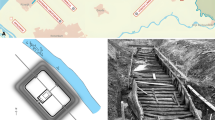Abstract
Trichosporonoides australiense sp. nov.: a basidiomycetous yeast-like fungus is described and illustrated with information on some physiological characteristics based on a single strain isolated from sweetened orange/mango in Australia. The differences between it and already described members of the genus are discussed. The new species may be distinguished principally by its inability to ferment sucrose and maltose. A dichotomous key to all described members of the genus is provided.
Similar content being viewed by others
References
Cole GT. The Thallic mode of conidiogenesis in Fungi Imperfeci. Can J Bot 1975; 53: 2983–3001.
Haskins RH, Spencer JFT. Trichosporonoides oedocephalis nov. gen. nov. sp. I. Morphology, development and taxonomic position. Can J Bot 1967; 45: 515–520.
Hoog GS, de. Taxonomic reviews of Moniliella, Trichosporonoides and Hyalodendron. Stud Mycol 1979; 19: 1–36.
Walt JP, van der, Yarrow D. Methods for the isolation, maintenance, classification and identification of yeasts. In Kreger-van Rij (ed), The Yeasts, a taxonomic study. Elsevier Science Publishers B.V. Amsterdam, 1984; 45–103.
Author information
Authors and Affiliations
Rights and permissions
About this article
Cite this article
Ramirez, C. A new species of Trichosporonoides isolated from sweetened orange/mango drink in Australia. Mycopathologia 108, 25–30 (1989). https://doi.org/10.1007/BF00436780
Issue Date:
DOI: https://doi.org/10.1007/BF00436780




